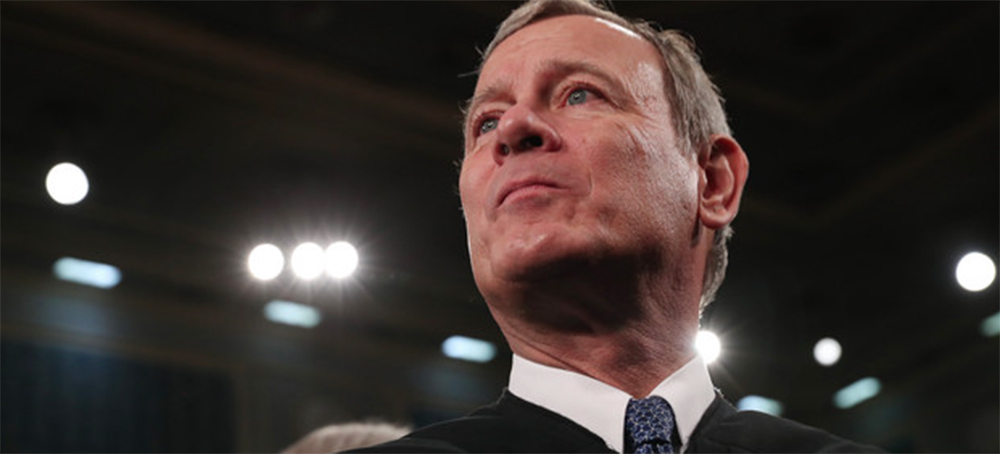The Supreme Court’s Big New Term
Amy Davidson-Sorkin The New Yorker John Roberts. (photo: Leah Millis/Getty Images)
John Roberts. (photo: Leah Millis/Getty Images)
There is a feeling with this Court that the conservative Justices could make a landmark ruling out of almost any case.
There’s an element of denialism in Roberts’s words that does not bode well for the Court’s new term, which begins on Monday and includes another set of potential landmark cases. He’s correct that, in our system, the Court is the institution designed to insure that our laws align with our rights. But the lack of alternatives just shows how much is at stake—we could end up with no arbiter that is seen as legitimate at all. Fears about the Court’s direction are not irrational, and they are widely shared. Every year since 1972, Gallup has asked Americans whether they trust “the judicial branch headed by the U.S. Supreme Court.” In the latest survey, released last week, the portion who do is at a record low: forty-seven per cent. Just forty per cent approve of the job that the Court itself is doing. An Associated Press/NORC Center poll this summer found that two-thirds of Americans think Justices should have term limits rather than lifetime appointments—a measure of discontent with the Court.
If Roberts is still confused, he could, for guidance, look to comments that Justices Sonia Sotomayor and, especially, Elena Kagan have made since the Dobbs ruling. In late September, at Salve Regina University, in Rhode Island, Kagan noted that people are right to worry about “the whole legal system being kind of up for grabs” after a change to the composition of the Court, with decisions that seem driven by ideology and divorced from legal principles. “It just doesn’t look like law when, you know, the new judges appointed by a new President come in and just start tossing out the old stuff,” she said.
Those new Justices were presumably the three nominated by Donald Trump: Neil Gorsuch, Brett Kavanaugh, and Amy Coney Barrett. They form a radical-conservative majority with Justices Clarence Thomas and Samuel Alito, and a supermajority when Roberts joins them, as he often does. One of the major issues before the Court this term is affirmative action; oral arguments in two related cases, Students for Fair Admissions v. Harvard and S.F.F.A. v. University of North Carolina, will be heard on October 31st. Roberts has opposed affirmative action in the past. At a minimum, he and the other conservative Justices are expected to rule that the current use of race as a factor in college admissions is unconstitutional. It seems possible that they will find a way to outlaw many race-based hiring initiatives at private companies as well. With this Court, it is difficult to predict how far the decisions might go. The rulings will likely not come for several months. (Ketanji Brown Jackson, the newest Justice, has recused herself from the Harvard case because she served on the university’s Board of Overseers.)
Yet there is a feeling that the conservative Justices could make a landmark ruling out of almost any case. Sackett v. Environmental Protection Agency, the first case of the term, may seem to address a narrow question—the definition of “navigable waters”—but it could become a vehicle for dismantling a wide range of regulations. Haaland v. Brackeen, a challenge to the 1978 Indian Child Welfare Act, could upend relations between the government and federally recognized tribes. The Court will also adjudicate a suit, brought by Texas and Louisiana, claiming that the Biden Administration has, in effect, broken the law by focussing its border-enforcement efforts only on certain categories of migrants, such as those deemed a “threat to public safety.” Notably, some Republicans have raised the possibility that, if the G.O.P. takes control of the House after the midterms, they may impeach President Biden on similar grounds.
The most explosive cases, however, may be the ones in which the Court will rule on how elections work. One of them, Merrill v. Milligan, will be heard on Tuesday. After the 2020 census, Alabama redrew its congressional districts; the new map, like the old one, has only one Black-majority district out of seven, in a state that is more than a quarter Black. Local civil-rights groups are challenging the map under the Voting Rights Act, but their chances seem dim. In 2013, Roberts wrote the majority opinion in Shelby County v. Holder, a case that significantly weakened the act, and there is concern that Merrill may finish it off. At Salve Regina, Kagan said, of the Justices’ mandate to protect voting rights, “I don’t think the Court has done this job particularly well.”
Merrill may be a prelude to a case that could be even more destabilizing to American democracy: Moore v. Harper, for which the oral arguments have yet to be scheduled. Moore also involves congressional-district maps—this time for North Carolina. After the state’s highest court threw out a gerrymandered map, Republican legislators appealed. The Supreme Court eventually took the case and agreed to consider a version of what is known as the “independent state legislature” theory, which holds that the power the Constitution grants state legislatures to organize elections cannot be limited by a state’s judiciary or constitution—or perhaps by much of anything. A broad decision in the case could make it far easier for state legislatures to engage in gerrymandering or voter suppression, or to intervene even more directly in the electoral process.
After the 2020 election, Trump’s team tried to pressure state legislators to send slates of “alternate” electors to Congress. In 2024, some legislators may be convinced that a majority of the Justices have given them license to do so. A reprise of January 6th is not so hard to imagine. If Roberts then finds himself, once again, driving past barricades, they may be ones that the Court helped to build



